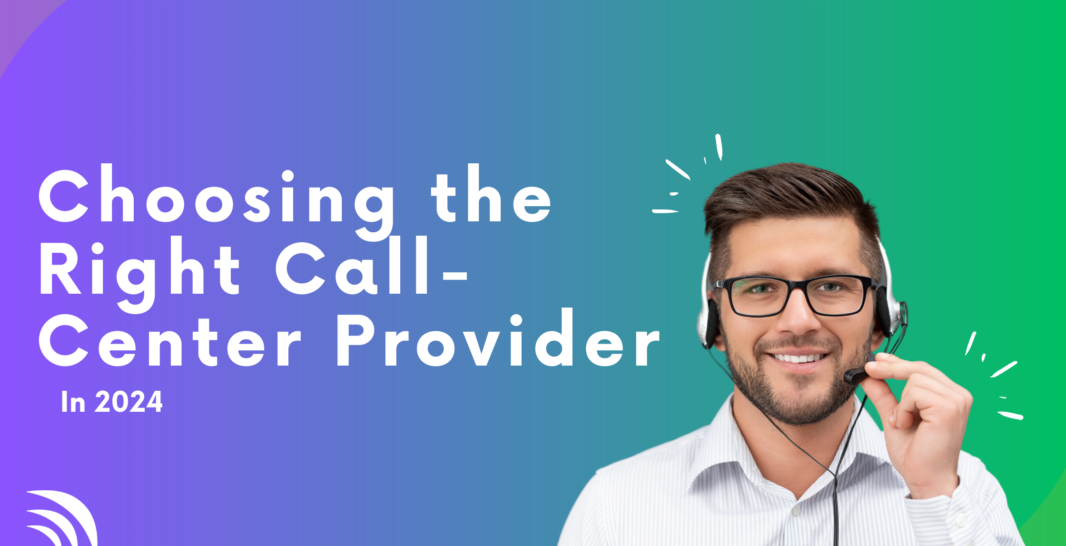The Ultimate Guide to Choosing the Right Call Center Provider for Your Business
Did you know that 90% of customers are likely to switch to a competitor after a poor customer service experience? In today’s fast-paced business environment, delivering exceptional customer service is no longer a luxury—it’s a necessity. For many organizations, this means partnering with a call center provider to manage customer interactions efficiently and effectively. However, with the myriad of options available, choosing the right call center solution can be a daunting task. We understand the challenges you face. Perhaps you’re struggling with scalability issues as your business grows, or you’re concerned about integrating a new system with your existing infrastructure. Maybe you’re worried about costs spiraling out of control, or you’re unsure how to measure the return on your investment. These are all valid concerns, and you’re not alone in grappling with them. This comprehensive guide aims to demystify the process of selecting a call center provider. We’ll walk you through the key factors to consider, explore different types of solutions, and provide insights into implementation and measuring success. By the end of this article, you’ll be equipped with the knowledge to make an informed decision that aligns with your business needs and goals.The Importance of Selecting the Right Call Center Solution
Choosing the right call center provider is crucial for several reasons:- Customer Experience: Your call center is often the first point of contact for customers. The right solution can significantly enhance customer satisfaction and loyalty.
- Operational Efficiency: An effective call center solution streamlines processes, reducing costs and improving productivity.
- Competitive Advantage: Advanced features like AI-powered chatbots and omnichannel support can give you an edge over competitors.
- Scalability: The right solution grows with your business, adapting to changing needs without requiring a complete overhaul.
- Data-Driven Insights: Modern call center solutions provide valuable analytics that can inform business decisions and strategies.
Key Factors to Consider When Choosing a Call Center Provider
1. Scalability and Flexibility
Look for a solution that can easily scale up or down based on your business needs. This is particularly important for businesses with seasonal fluctuations or rapid growth projections. Cloud-based solutions often offer greater flexibility in this regard.2. Features and Functionality
Consider the specific features that are most important for your business. Let’s dive deeper into some key functionalities:Omnichannel Communication Support
Ensure seamless customer interactions across various channels like voice, email, chat, and social media. This unified approach enhances customer experience and streamlines agent workflows.Interactive Voice Response (IVR)
An advanced IVR system can significantly reduce call volumes by providing self-service options and efficiently routing calls to the right department or agent.Automatic Call Distribution (ACD)
ACD systems intelligently route calls based on predefined rules, ensuring efficient call handling and reduced wait times.Computer Telephony Integration (CTI)
CTI enables the integration of telephone systems with computer systems, providing agents with instant access to customer information and enhancing call handling efficiency.Customer Relationship Management (CRM) Integration
Seamless CRM integration allows agents to access and update customer information in real-time, leading to more personalized and efficient customer interactions.Voice over Internet Protocol (VoIP) Capabilities
VoIP technology offers cost-effective and flexible communication options, especially beneficial for businesses with remote or distributed teams.Unified Communications (UC)
UC platforms integrate various communication tools, improving collaboration among team members and enhancing overall productivity.Call Routing and Queuing
Advanced routing and queuing systems ensure that calls are directed to the most appropriate agent, reducing wait times and improving first-call resolution rates.Workforce Management Tools
These tools help optimize staffing levels, schedule agents efficiently, and manage performance, leading to improved operational efficiency.Quality Monitoring Features
Features like call recording and real-time monitoring help maintain service quality and provide valuable training opportunities for agents.Speech Analytics
Advanced speech analytics can provide insights into customer sentiment, identify trending issues, and help improve overall service quality.3. Integration Capabilities
Ensure the call center solution can integrate seamlessly with your existing systems, including CRM software, help desk tools, and other business applications. This integration is crucial for maintaining a unified view of customer interactions and streamlining workflows.4. Cost and Pricing Structure
Evaluate the total cost of ownership, including initial setup costs, ongoing subscription fees, and any potential hidden costs. Compare pricing models (per-seat vs. usage-based) to determine which is most cost-effective for your business.5. Customer Support and Training
Look for providers that offer comprehensive training programs and responsive customer support. This ensures your team can quickly adapt to the new system and resolve any issues promptly.6. Security and Compliance
Ensure the provider adheres to industry standards and regulations relevant to your business, such as HIPAA, PCI DSS, or GDPR. Data security should be a top priority, especially when handling sensitive customer information.7. Reliability and Uptime
Check the provider’s service level agreements (SLAs) and historical uptime records. A reliable call center solution is critical for maintaining continuous customer service operations.8. Reporting and Analytics
Look for robust reporting capabilities that provide actionable insights into call center performance, customer behavior, and agent productivity. Advanced analytics can help you continually optimize your customer service operations.Types of Call Center Solutions
Let’s take a closer look at the different types of call center solutions and their suitability for various business needs:On-Premises Systems
Pros:- Complete control over hardware and software
- Potentially lower long-term costs for large enterprises
- Higher level of customization
- Significant upfront investment
- Requires dedicated IT staff for maintenance
- Less flexibility for remote work scenarios
Cloud-Based Solutions
Pros:- Lower upfront costs
- Easy scalability
- Accessible from anywhere with internet connection
- Regular updates and new features
- Ongoing subscription fees
- Potential security concerns for highly sensitive data
- Dependence on internet connectivity
Hybrid Models
Pros:- Combines benefits of both on-premises and cloud systems
- Allows for gradual migration to the cloud
- Flexibility to keep sensitive data on-premises
- Can be complex to manage
- Potential integration challenges
Evaluating Your Business Needs
Before choosing a provider, assess your specific requirements:- Call volume and patterns
- Required features and integrations
- Budget constraints
- Compliance and security needs
- Growth projections
- Customer service goals
Comparing Top Call Center Providers
Here’s a comparison table of some leading call center providers:| Provider | Key Features | Pricing Model | Best For |
|---|---|---|---|
| Nextiva | All-in-one communication platform, AI-powered automation | Per user/month | Small to medium businesses |
| Five9 | Robust cloud contact center, extensive integrations | Custom pricing | Medium to large enterprises |
| Genesys | Omnichannel engagement, advanced analytics | Custom pricing | Large enterprises with complex needs |
| Twilio | Highly customizable, pay-as-you-go model | Usage-based | Businesses needing flexible, scalable solutions |
| Amazon Connect | Pay-per-use pricing, AI-powered features | Usage-based | Organizations of all sizes seeking cost-effective solutions |
Implementation and Onboarding Process
A smooth implementation is crucial for realizing the benefits of your new call center solution. Here’s a step-by-step guide to ensure a successful implementation:- Project Planning: Define clear objectives, timelines, and responsibilities.
- System Design: Work with the provider to design a solution that meets your specific needs.
- Data Migration: Plan and execute the transfer of existing customer data and call histories.
- Integration: Connect the new system with your existing tools and workflows.
- Testing: Conduct thorough testing of all features and integrations.
- Training: Provide comprehensive training for all users, including agents and administrators.
- Go-Live: Launch the new system, ensuring adequate support during the transition.
- Post-Implementation Review: Evaluate the system’s performance and address any issues.
Measuring Success and ROI
To ensure your call center solution delivers value, track these key performance indicators (KPIs):- First Call Resolution (FCR) Rate: Percentage of customer issues resolved on the first contact.
- Average Handle Time (AHT): The average duration of a customer interaction.
- Customer Satisfaction Score (CSAT): Measure of customer satisfaction with their service experience.
- Net Promoter Score (NPS): Indicator of customer loyalty and likelihood to recommend your business.
- Cost per Call: Total operational costs divided by the number of calls handled.
- Agent Productivity Metrics: Including occupancy rate, adherence to schedule, and quality scores.
Emerging Technologies in Call Center Solutions
Stay ahead of the curve by understanding these emerging technologies:- Artificial Intelligence and Machine Learning
- Predictive analytics for anticipating customer needs
- AI-powered chatbots for handling routine inquiries
- Sentiment analysis for real-time emotion detection
- Advanced Speech Analytics
- Intent detection for more accurate call routing
- Compliance monitoring to ensure adherence to regulations
- Automated quality scoring for consistent performance evaluation
- Augmented Reality (AR) for Visual Support
- Enhanced troubleshooting capabilities
- Improved product demonstrations and support
- Internet of Things (IoT) Integration
- Proactive customer support based on device data
- Improved inventory and supply chain management
- Blockchain for Enhanced Security
- Secure storage of sensitive customer data
- Improved authentication processes
Next Steps
Choosing the right call center provider is a critical decision that can significantly impact your business’s customer service capabilities and overall success. By carefully considering the factors outlined in this guide, you’ll be well-equipped to make an informed choice that aligns with your unique needs and goals.Action Plan for Choosing Your Call Center Provider:
- Assess your current customer service capabilities and pain points
- Define your specific requirements and goals
- Research and shortlist potential providers based on your needs
- Request demos and trials from your top choices
- Evaluate providers based on features, pricing, and compatibility with your business
- Check references and case studies from similar businesses
- Make your decision and plan for implementation

